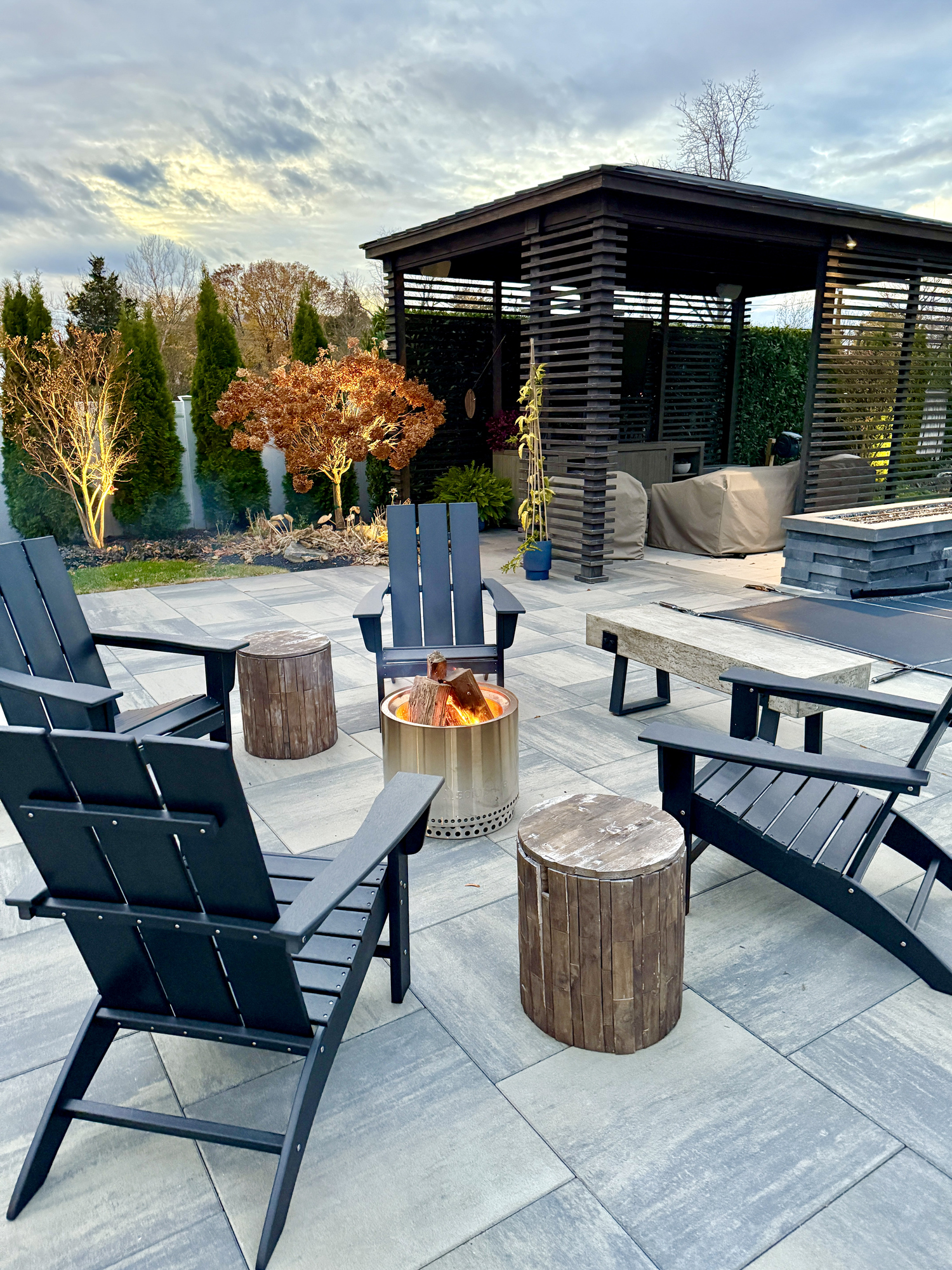In the fast-paced world of business, where long hours and endless meetings can drain even the most invigorated minds, finding ways to boost creativity and performance is more important than ever. One surprising solution lies beyond the glass walls of our offices—outdoor patio sanctuaries. Imagine stepping outside for a breath of fresh air and feeling your stress dissipate while your ideas flow freely in the sunshine. It’s not just about getting some sun; research shows that these green spaces can drastically improve job satisfaction, collaboration, and even mental clarity. As we dive into the myriad ways these outdoor retreats enhance the working lives of C-suite executives, prepare to rethink what a conducive work environment looks like.
Outdoor patio sanctuaries significantly boost peak performance for C-suite executives by providing a tranquil environment that promotes mental well-being and creativity. Studies have shown that access to natural elements and fresh air can lead to a 34% increase in job satisfaction, ultimately enhancing workplace performance and fostering collaboration among teams.
Benefits of Outdoor Patio Sanctuaries
One of the most compelling benefits of these outdoor spaces is the boost in job satisfaction. Executives who can step away from confined office walls and immerse themselves in nature report feeling more engaged and fulfilled. A well-designed outdoor area doesn’t just serve as a pleasant escape; it revitalizes the mind. Research reveals that employees with access to such environments are 15% more likely to express satisfaction with their jobs. Think of how refreshing it is to take a meeting outdoors under the warmth of the sun, with a gentle breeze stirring through the leaves—a stark contrast to the sterile feel of indoor offices.
Beyond merely lifting spirits, these outdoor sanctuaries help sharpen the mind and improve focus, creating an inviting atmosphere that promotes clear thinking.
Enhanced Focus and Concentration
Studies consistently show that spending time in natural surroundings can have dramatic effects on cognitive functions like focus and concentration. For instance, a University of Michigan study determined that participants demonstrated a remarkable 20% improvement on memory tests after a brief walk in nature rather than in an urban context. What’s at play here? Nature offers a reprieve from constant digital stimulation—a chance for executives to recharge mentally. This shift in environment allows for fresh ideas to flow and reduces cognitive fatigue, which enhances overall productivity.
But the benefits don’t stop there; there's also evidence suggesting outdoor spaces foster collaboration among teams.
Improved Team Collaboration and Communication
Access to outdoor areas not only boosts individual performance but significantly enhances teamwork as well. Imagine a brainstorming session taking place under blue skies instead of fluorescent lighting—employees naturally feel more relaxed and open, cultivating an atmosphere ripe for creative exchanges. According to recent statistics, 60% of C-suite executives believe outdoor settings facilitate better team communication and collaboration. When people feel comfortable, they're more likely to express ideas freely and build off one another's contributions.
The calming effects of nature extend even further to personal well-being, impacting both stress levels and general health.
Reduction of Stress Levels
Outdoor patios lined with greenery can translate directly into reduced stress levels, promoting better overall health amongst executives. Research reveals that spending time in green spaces can cut stress by up to 30%. The presence of plants noticeably lowers cortisol levels—the hormone associated with stress—allowing executives to engage in their work with renewed vigor. When tranquility permeates an environment, it becomes easier to navigate challenges throughout the day.
In addition to enhancing psychological well-being, these outdoor spaces can also serve practical purposes.
Versatile Use for Relaxation and Gatherings
The flexibility that outdoor sanctuaries afford is another notable benefit. They’re not just for individual use—they can host gatherings, providing an ideal setting for both relaxation and collaboration. Installing features like weather-resistant seating or cozy fire pits creates a welcoming space where teams can unwind or strategize together. Furthermore, amenities like electrical circuits for fans can improve comfort on warm days, enabling year-round enjoyment irrespective of weather conditions.
As we explore how these elements contribute to employee happiness and effectiveness, it's worth looking at other factors that further elevate the workplace experience.
Enhancing Productivity and Creativity
Outdoor patio sanctuaries play a pivotal role in enhancing productivity and creativity among C-suite executives. Nature isn’t just a pretty backdrop; it acts as a catalyst for fresh ideas and renewed focus. Just imagine being immersed in a lush green space with the gentle rustle of leaves in the breeze as your mind drifts freely—this is where the magic happens. Studies show that simply stepping outside can significantly reduce mental fatigue.
For instance, CEO Mark Parker from Nike mentions that his best creative breakthroughs often strike while he’s working in his outdoor garden office. This isn’t mere coincidence; it’s backed by research indicating that natural environments can increase creativity by up to 50%.
As the soothing effects of nature seep into daily operations, we begin to see the positive influence on teamwork as well.
Stimulating Creativity
It's not just about individual thinkers; stimulating creativity ignites collaboration across teams as well. When employees gather outdoors, they tend to engage more openly, sharing ideas without the constraints of formal indoor environments. A study by the Journal of Environmental Psychology emphasizes this phenomenon, showing that employees feel more at ease and vibrant in outdoor settings, leading to dynamic discussions.
In essence, the very act of getting some sunshine diminishes walls—not just physical ones but metaphorical barriers that inhibit interaction. Imagine a team huddled around a fire pit or seated comfortably under a gazebo, exchanging thoughts freely while enjoying the beauty of their surroundings. This picturesque scene opens channels for innovative brainstorming sessions—a key element in problem-solving and idea generation.
Beyond enhancing creativity and collaboration, outdoor spaces invite numerous design elements that can further foster engagement and inspire unique solutions.
Supporting Collaborative Thinking
The modern corporate landscape rewards companies that prioritize environments conducive to innovation. Apple’s commitment to outdoor meeting spaces is a prime example of leveraging natural settings for optimal collaborative thinking. Employees are encouraged to step outside during meetings which not only facilitates relaxed interaction but also leads to innovative product ideas over time.
Research indicates that outdoor areas boost firm dynamics: organizations providing access to these spaces report a remarkable 60% improvement in collaboration among employees traditionally confined indoors.
To fully harness these benefits, it's essential to pay attention to the aesthetic appeal and functionality of these outdoor spaces. Thoughtful design incorporating comfortable seating, greenery, and even water features can create an inviting atmosphere for serious discussions and lighthearted exchanges alike. Remember, it’s about more than just aesthetics; enhancing comfort with amenities such as shades for sunny days or heaters for chillier evenings can turn a simple gathering into a productive retreat.
With such compelling evidence showcasing how these outdoor sanctuaries elevate workplace dynamics, we can now explore how they contribute to overall wellness and mental health.
Reducing Stress and Improving Mental Health
High-pressure roles often envelop executives in a blanket of stress, causing mental fatigue that can be overwhelming. Here is where outdoor patios come in as not just a luxury but a necessity for well-being. Research indicates that spending just 20 minutes a day in nature can lead to a significant reduction in cortisol levels—by up to 15%—promoting a calmer, more focused mindset. Lowering cortisol isn't simply about feeling better on a cloudy Tuesday; it translates into improved decision-making, clearer thinking, and ultimately better performance at work.
How does this work? When you step outside, your senses are stimulated by fresh air and natural light. This exposure revitalizes the mind, allowing for breaks in the relentless cycle of pressure that comes from high-stakes decision-making. Natural environments improve mood and restore attention, which might explain why many executives report feeling rejuvenated after just a short break spent outdoors.
Moreover, creating a serene outdoor sanctuary encourages regular use of these calming settings. Consider the experience of Sarah Thompson, a CFO of a Fortune 500 company who shares her personal insight: “Spending just an hour in my outdoor sanctuary helps me reset and find balance.” Her words underscore how vital these retreats are for reestablishing mental equilibrium.
And the impact is clear. A well-structured outdoor space—complete with comfortable seating arrangements and perhaps the lulling sound of water features—becomes an oasis where employees can step away from their desks and recharge. Working outdoors fosters creativity while also reminding us of life’s simple joys; it keeps burnout at bay.
Studies also suggest that access to nature returns astounding dividends, not only reducing stress but improving job satisfaction by up to 25%.
By incorporating natural elements like greenery and water fountains into these patio designs, companies can significantly enhance their employees' emotional health and productivity levels. As we consider the next steps, it's important to explore the key features that contribute to these inviting outdoor spaces.
Essential Design Elements
First and foremost, comfortable and durable furniture is crucial. Just imagine settling into a plush, weather-resistant chair after a long day—it's a simple luxury that elevates the patio experience significantly. For executives wanting to find the perfect piece for relaxation and focus, an outdoor lounge chair buyer's guide offers detailed advice on finding the best chaises and recliners. It’s important to select chairs that support good posture, which is vital since many professionals often work outdoors for extended periods.But comfort alone isn't enough; integrating natural elements is equally important for well-being.
Greenery and Natural Elements
Including a variety of plants, from potted arrangements to vertical garden walls, has incredible benefits. Plants help reduce stress levels by up to 15% and improve air quality as they effectively filter toxins. Fresh foliage brings life into the space while also creating a serene atmosphere perfect for contemplation or casual brainstorming sessions. Additionally, adding water features such as small fountains can provide calming sounds that promote relaxation and stimulate creativity.
| Element | Benefit |
| Comfortable Furniture | Prolongs time spent comfortably outdoors |
| Greenery | Reduces stress, improves overall air quality |
| Water Features | Provides soothing sounds, enhances visual appeal |
Once these core design elements are in place, it's essential to consider how successful leaders are leveraging these ideas to maximize productivity and creativity in their environments.
CEO Insights and Success Stories
Not only do successful executives like Jeff Bezos and Sheryl Sandberg find solace in nature-inspired settings, but they also recognize the potential of outdoor spaces to enhance organizational outcomes. By incorporating patio sanctuaries into their work environments, executives are investing in a psychological boost that propels their teams toward greater achievements.
Insights from Leading Executives
For instance, Elon Musk, CEO of Tesla and SpaceX, has emphasized the importance of creative thinking in innovation. He advocates for open-air meetings with his team because he believes that changing scenery fosters new perspectives. It’s a common thread among top leaders: creating a distinct environment encourages staff to think outside the box, leading to dynamic discussions and innovative ideas. Musk once noted, "Sometimes a breath of fresh air is all it takes to spark a revolutionary idea."
This sentiment resonates with many C-suite executives who have witnessed a direct correlation between outdoor spaces and enhanced team collaboration. Take Microsoft’s new campus as a case in point. The incorporation of ample green zones has improved employee morale and led to measurable increases in productivity. Employees report feeling more motivated and engaged when surrounded by greenery and natural light—elements that are inherently relaxing.
Research supports this idea; according to a survey by Workplace Trends, 72% of executives believe outdoor spaces foster creativity among employees. A significant majority recognizes these serene settings—not just for relaxation but as critical tools for driving innovation and performance.
Real-World Impact
As companies blanket their facilities with inviting patios, they create multifunctional areas for both social interactions and focused work sessions. Google has taken this approach seriously, designing open-air offices where employees can switch seamlessly between casual brainstorming sessions and more structured meetings—even integrating technology solutions within these outdoor settings so remote participants can join from anywhere.
Such versatility transforms outdoor spaces into vital hubs for synergy and connectivity, helping teams recharge during breaks while fostering collaboration. Organizations report that hosting informal meetings outdoors can lead to quicker resolutions than traditional boardroom discussions. The change in atmosphere seems conducive to better communication, where ideas flow freely among team members.
In examining how these features integrate into overall business strategies, we now turn our attention to the far-reaching effects on company performance as organizations embrace this innovative approach to workspace design.
Impact on Business Performance
The positive impact on individual C-suite executives ultimately filters down to overall business performance. When leaders are mentally refreshed and physically revitalized—from spending time in nature during their workday—they often inspire similar feelings in their teams, creating a domino effect that enhances productivity throughout the organization.
Increased Employee Engagement
Studies have shown that companies with outdoor spaces report a 60% increase in collaboration among employees. This is not just a statistic; it represents real transformation within workplace dynamics. For instance, firms like Microsoft have noticed a marked improvement in employee engagement and morale due to increased access to outdoor workspaces. Fresh air and natural light create an inviting atmosphere where innovative ideas can flourish.
Employees feel more connected to their colleagues, which fosters teamwork—an essential ingredient for success. When people gather outside, they're freer to express creativity and are less inhibited, making brainstorming sessions more productive. Importantly, this doesn’t just improve the work environment; it directly impacts the bottom line through increased synergy and idea sharing.
Regular exposure to nature revives energy levels and encourages spontaneous conversations that can lead to groundbreaking projects or solutions.
Improved Decision-Making
Another compelling aspect of outdoor workspaces is their effect on decision-making processes. Better mental health and reduced stress result in clearer, more effective decision-making. Executives who regularly spend time in natural settings have been found to be 23% more satisfied with their decision-making abilities according to a Gallup poll. This altered mindset allows for greater focus and clarity during critical times when choices must be made swiftly and confidently.
Imagine taking a break amidst greenery after a long meeting; you’re likely to return with a lighter heart and sharper mind thanks to the renewal provided by nature. It’s a simple yet profound shift that can determine whether a company thrives or merely survives.
Inspired by the benefits and success stories, establishing your own outdoor retreat offers substantial advantages for both mental well-being and enhanced operational efficiency. Let’s explore practical steps you can take to cultivate this transformative environment.
Setting Up Your Own Sanctuary
Setting up an outdoor patio sanctuary is simpler than it might seem but requires thoughtful planning.
The first step involves assessing your space. You’ll want to identify an area that receives ample sunlight during the day while also ensuring options for shade when needed. Think of this as creating a mini-ecosystem, where balance is key. A sunny spot can invigorate your mind, while shaded areas provide a retreat from the heat and keep everyone comfortable during warm afternoons. Ideally, this area should be easily accessible from your office or workspace, allowing you quick access when you need a break or a fresh perspective.
Once you have determined the right location, it’s time to invest in quality furniture and decor to enrich your sanctuary.
When selecting outdoor furniture, prioritize quality that can withstand various weather conditions while also providing comfort. Trendy options like weather-resistant seating not only serve a functional purpose but also add aesthetic appeal to your space. Ergonomic designs with lumbar support can significantly improve comfort during longer brainstorming sessions or periods of relaxation. Consider adding cushions with vibrant colors or patterns that complement your garden theme; they enhance seating comfort and visually transform the atmosphere of your sanctuary.
Now that you've established how to make your outdoor space comfortable and inviting, let’s discuss how to further enhance the ambiance with natural elements.
Incorporating plants, water features, and other natural elements creates a calming environment conducive to relaxation. Research has shown that simply having 1-2 plants per 100 square feet can improve both air quality and productivity—an easy win for any outdoor setting! Consider including potted plants that bloom throughout different seasons, or perhaps garden walls adorned with vibrant greenery that can act as living art. The gentle sound of water from fountains or small ponds can have a soothing effect, enhancing the tranquil atmosphere you're cultivating. Furthermore, an outdoor fireplace adds warmth on cooler nights and serves as a gathering spot for informal meetings or peaceful reflection.
Personalizing your space is equally important to ensure it effectively serves its purpose as a retreat.
Customizing your sanctuary with personal touches will make it an effective retreat for stress relief and creative thinking. This could mean hanging artwork that resonates with you or using fabric elements that reflect your personality. Adding comfortable blankets for chilly evenings will encourage extended use of the space well into the fall months. Don’t shy away from incorporating functional features like electrical outlets for ceiling fans or charging stations for devices; these little conveniences can make all the difference when working outside.
Overall, through careful consideration of your space, investment in quality furnishings, incorporation of natural elements, and thoughtful personalization, you will create an outdoor patio sanctuary designed not just for relaxation but specifically to enhance peak performance in both work and leisure activities. By embracing all aspects of design and comfort in this special space, you're fostering an environment where creativity thrives and productivity flourishes amidst nature's beauty.














